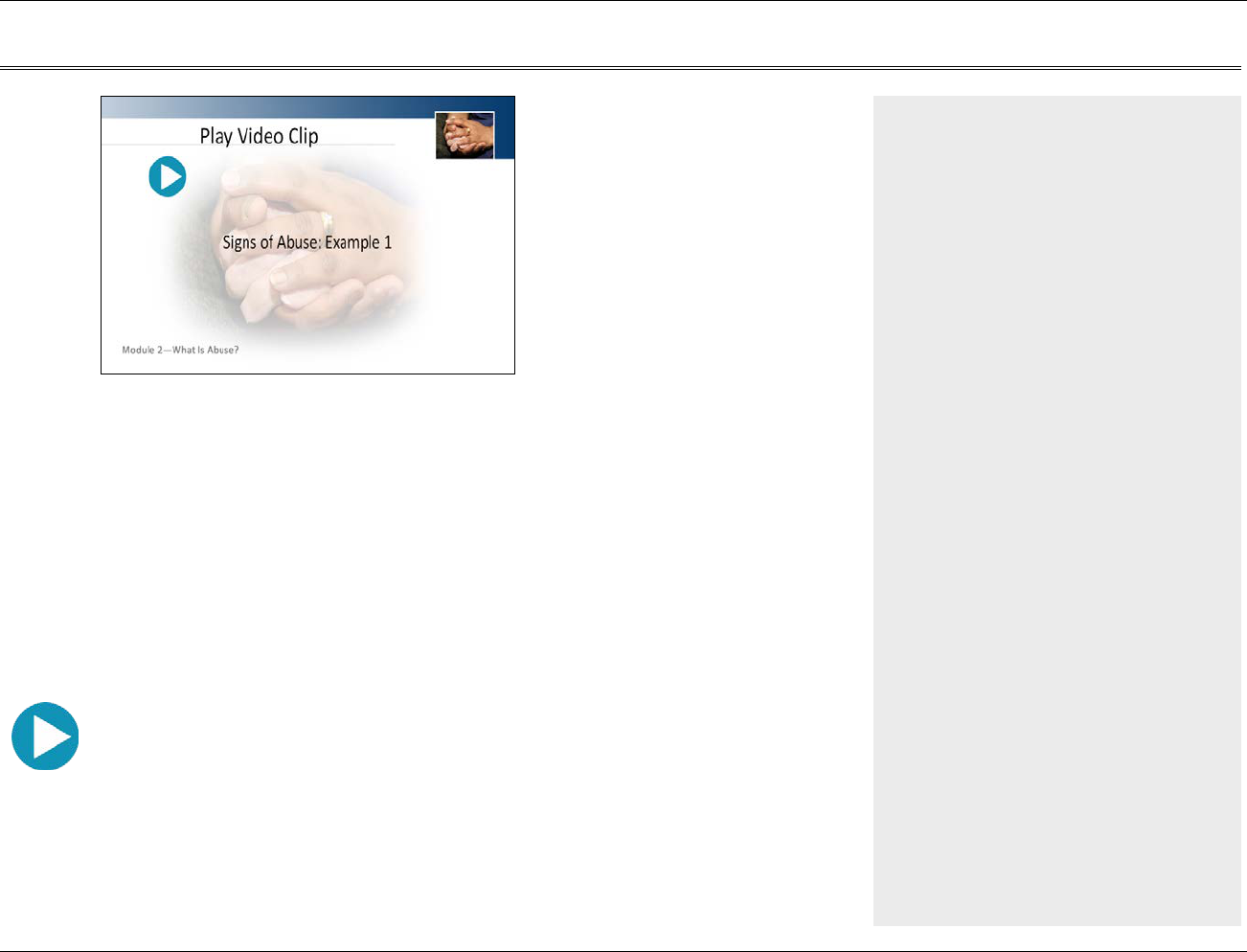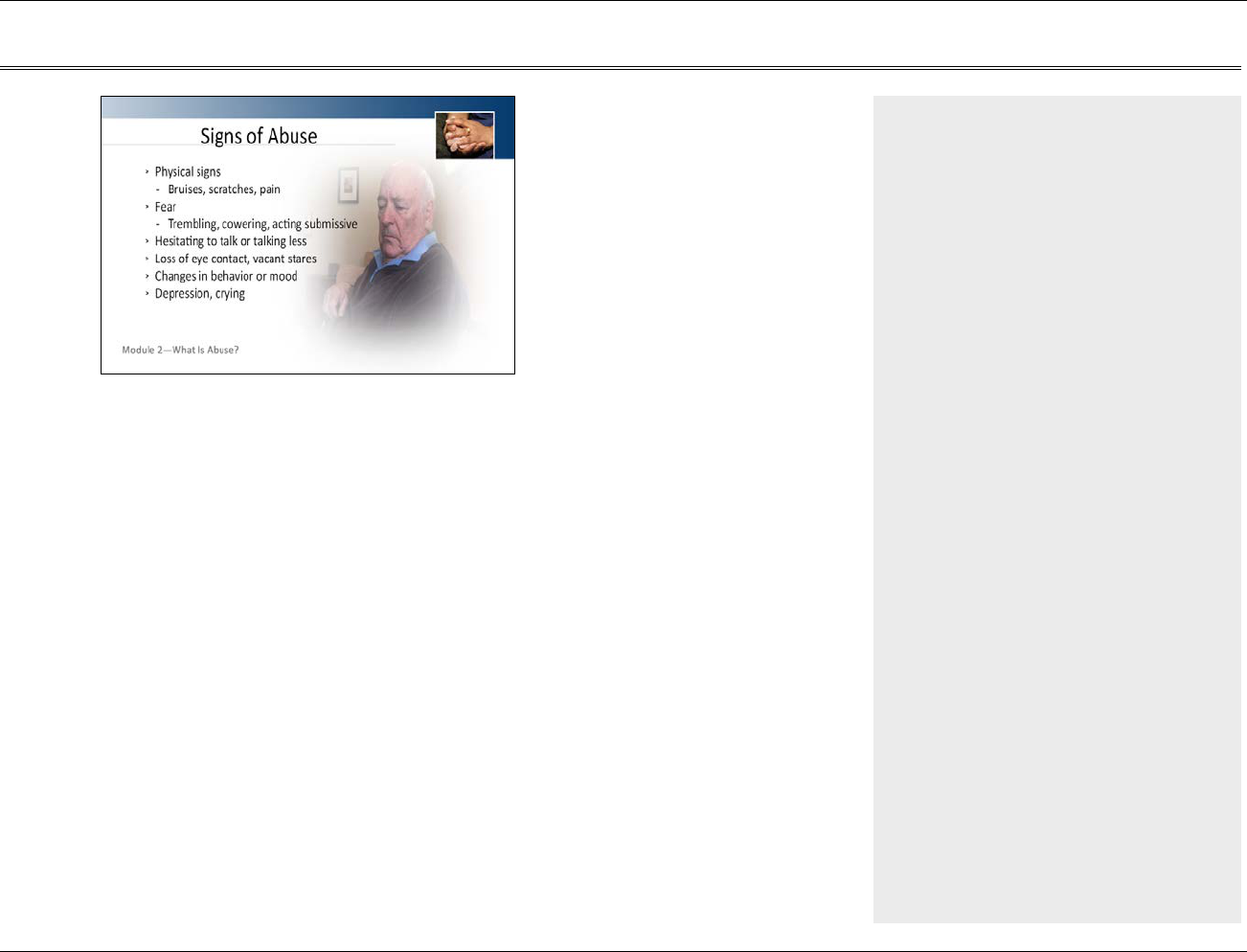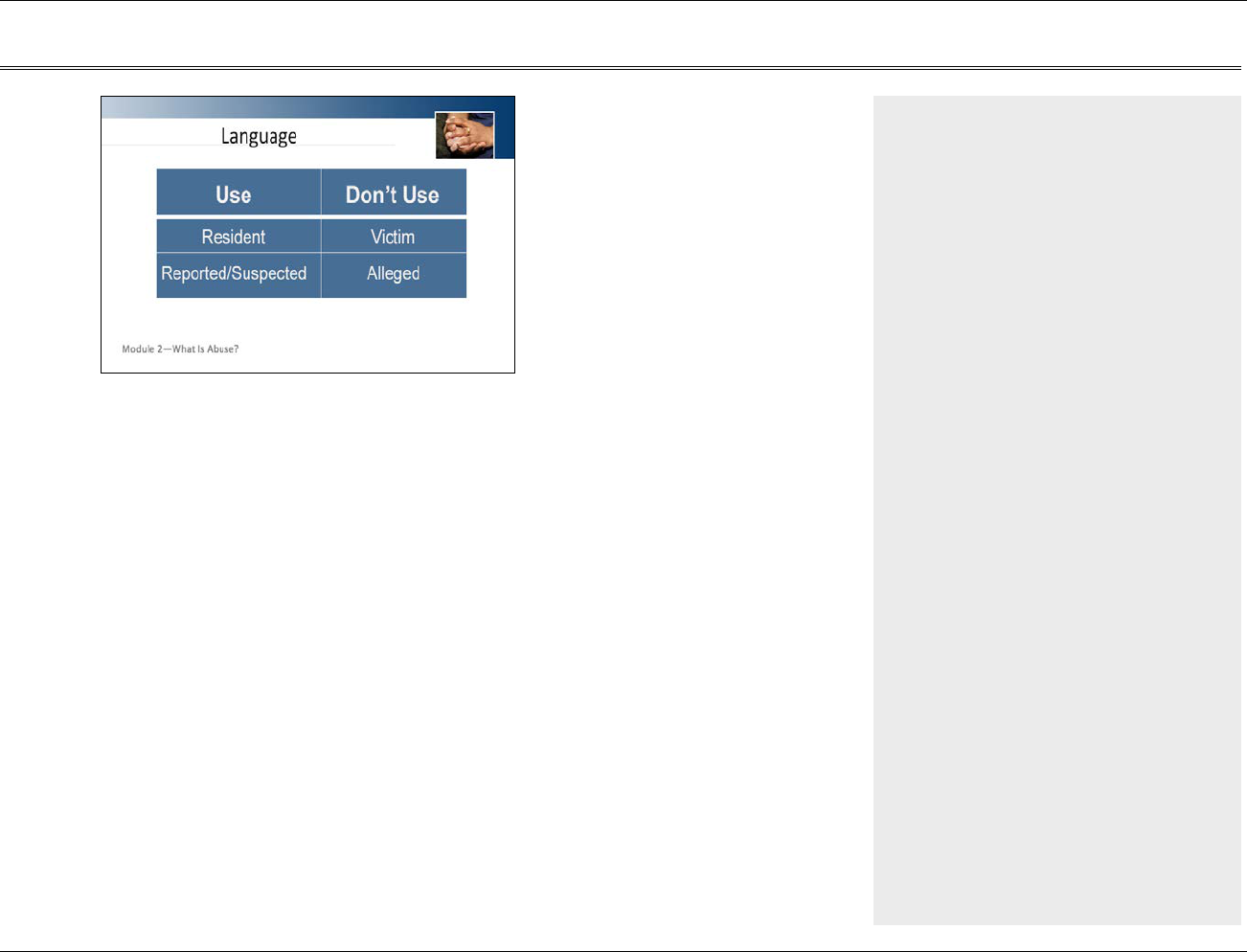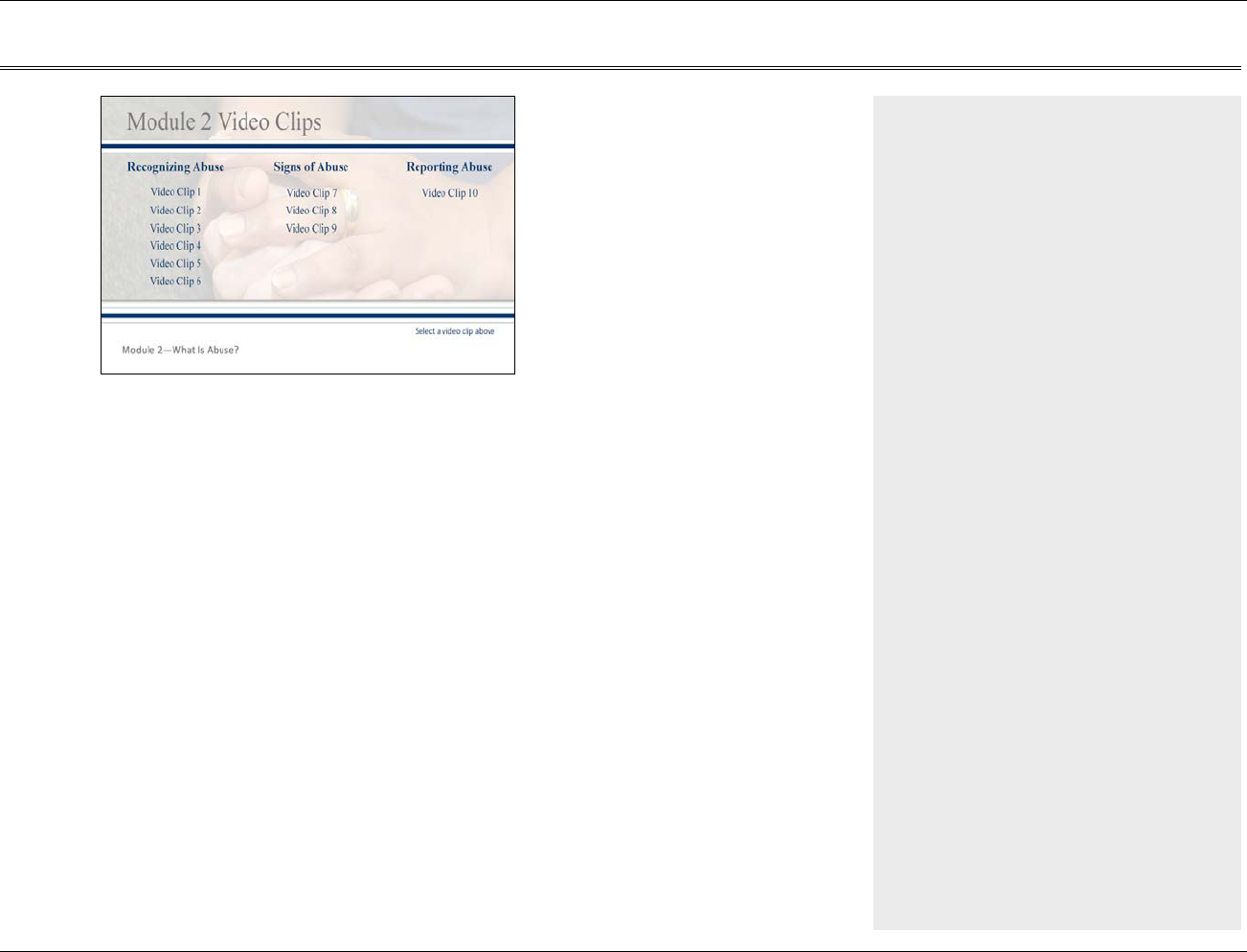
Hand in Hand: A Training Series for Nursing Homes
Instructor Guide
Module 2:
What Is Abuse?

Hand in Hand: A Training Series for Nursing Homes Module 2: What Is Abuse?
Centers for Medicare & Medicaid Services 2
This page intentionally left blank.

Hand in Hand: A Training Series for Nursing Homes Module 2: What Is Abuse?
Centers for Medicare & Medicaid Services 3
Methodology
This module uses lecture, interactive discussion and exercises.
(Total Time: 63 minutes)
Estimated Time
Lecture/Discussion
Page
1 minute ................................................................ Welcome ........................................................................................................................... 4
5 minutes ............................................................... Warm-Up Exercise: What Is Abuse? ...........................................................................6
1 minute ................................................................ Module Objectives ........................................................................................................... 8
13 minutes ............................................................. Types of Abuse ...........................................................................................................12
14 minutes ............................................................. Recognizing Abuse .....................................................................................................42
10 minutes ............................................................. Signs of Abuse ............................................................................................................80
18 minutes ............................................................. Reporting Abuse .......................................................................................................106
1 minute ................................................................ Conclusion ............................................................................................................... 148
Appendix
Page
Circle of Abuse ....................................................................................................................................................................................... A-2
Handout: How to Report Abuse .............................................................................................................................................................. A-3
Handout: How to Report Abuse: Writing the Report ............................................................................................................................. A-5
Training Resources
• Television with DVD player or computer with DVD player
and LCD projector.
• Module 2 Instructor Guide.
• Module 2 DVD.
• Pens, pencils and writing tablets.
• Prizes (optional).
• Easel chart with markers.
Instructor Preparation
• Review the Instructor Guide and DVD. Practice exercise delivery. Rehearse with DVD. Print copies of the handouts. Have
available your nursing home’s policy on reporting abuse.

Hand in Hand: A Training Series for Nursing Homes Module 2: What Is Abuse?
Centers for Medicare & Medicaid Services 4
I. Welcome
Welcome to Module 2: What Is Abuse?—Slide 1 of 5
Instructor Guidance:
If the participants do not know each other, have each participant state his or her
name, position and where he or she works in the nursing home.
Notes:
To give you more flexibility in introducing the module, there isn’t a
recommended script. Instead, you will find a DO action that outlines the topics
to cover on the welcome slide. You will want to ensure that participants are
comfortable, that they know who you are and that they understand that Module
2: What Is Abuse? will take approximately one hour to complete.
Be sure to pass out a sign-in sheet to track attendance.
1

Hand in Hand: A Training Series for Nursing Homes Module 2: What Is Abuse?
Centers for Medicare & Medicaid Services 5
Slide 1 of 5
Welcome to Module 2: What Is Abuse?
Notes:
DO
• Greet participants.
• Welcome participants to the training.
• Have participants introduce themselves (if they don’t know each other).
SAY
Before we get started, I want to let you know that you will see some videos that
graphically portray abuse situations. They may disturb or upset you, but they
help us understand this very important topic of abuse.

Hand in Hand: A Training Series for Nursing Homes Module 2: What Is Abuse?
Centers for Medicare & Medicaid Services 6
II. Warm-Up Exercise: What Is Abuse?
Warm-Up Exercise—Slide 2 of 5
Instructor Guidance:
Instructor Goals
• To set the stage for participation throughout the training.
• To gather the participants’ thoughts on the meaning of abuse.
• To point out that people might think about abuse differently.
Notes:
Materials Needed
• Easel chart with markers.
• Treats (candy).
Participants will likely call out a wide variety of terms and examples. Point out
that participants might see abuse differently. There are no wrong answers in
this exercise.
If you think the participants might be uncomfortable talking in a large group,
you can separate the class into smaller groups and have each group share the
results of its discussion.
5

Hand in Hand: A Training Series for Nursing Homes Module 2: What Is Abuse?
Centers for Medicare & Medicaid Services 7
Slide 2 of 5
Warm-Up Exercise
Notes:
ASK
To get us started, what do you think of when you hear the word abuse? There
are no right or wrong answers—this is what you think.
DO
As the participants call out words or phrases, write them on the easel chart.

Hand in Hand: A Training Series for Nursing Homes Module 2: What Is Abuse?
Centers for Medicare & Medicaid Services 8
III. Module Objectives
Module Objectives—Slide 3 of 5
Instructor Guidance: Notes:
It’s important to set participant expectations by stating the module objectives. It
is not necessary to explain the objectives on this slide; you are only introducing
the anticipated instructional outcomes. This slide should take only about one
minute.
1

Hand in Hand: A Training Series for Nursing Homes Module 2: What Is Abuse?
Centers for Medicare & Medicaid Services 9
Slide 3 of 5
Module Objectives
Notes:
SAY
You already have your own ideas of what abuse is. We are going to build on
those ideas to further explore the concept of abuse.
Unfortunately, abuse can and does happen in many forms. Resident abuse can
come from many different individuals, including staff, visitors, family members
and other residents.
We know that you are working here because you care about the people who
live here. Because you care so much about them, we need your help in
preventing abuse. Working together, we can prevent it; we all have a part in
stopping abuse. This module will help you identify the types and signs of
abuse, as well as how to report it.

Hand in Hand: A Training Series for Nursing Homes Module 2: What Is Abuse?
Centers for Medicare & Medicaid Services 10
Module 2 Menu
Module 2 Menu—Slide 4 of 5
Instructor Guidance:
The menu slide allows you to easily navigate through the module by selecting
the lesson you want to present. At the end of the module, you can click the
forward arrow at the bottom of the slide to Module 2 Video Clips (slide 5 of 5).
These are the same video clips used in the lessons; they are available to you for
review and discussion once all lessons have been covered.
Notes:

Hand in Hand: A Training Series for Nursing Homes Module 2: What Is Abuse?
Centers for Medicare & Medicaid Services 11
Slide 4 of 5
Module 2 Menu
Notes:
SAY
Let’s get started with the first lesson, Types of Abuse.
DO
On the menu, click the first lesson, Types of Abuse.

Hand in Hand: A Training Series for Nursing Homes Module 2: What Is Abuse?
Centers for Medicare & Medicaid Services 12
IV. Types of Abuse
Types of Abuse: Goals—Slide 1 of 11
Instructor Guidance:
The goals of this lesson are for participants to:
• Understand the CMS definition of abuse.
• Learn about different types of abuse so that they are able to recognize
abuse if it happens to their residents.
Notes:
13

Hand in Hand: A Training Series for Nursing Homes Module 2: What Is Abuse?
Centers for Medicare & Medicaid Services 13
Slide 1 of 11
Types of Abuse: Goals
Notes:
SAY
As we saw in our warm-up exercise at the beginning of class, we might think of
abuse differently.
In this lesson, we will learn how the Centers for Medicare & Medicaid Services
(CMS) defines abuse. We’ll also learn about different types of abuse and give
you examples of each. Knowing about different types of abuse will prepare you
to recognize and report abuse if you see it.
Then, we’ll watch some video clips and talk about what type of abuse might be
happening.

Hand in Hand: A Training Series for Nursing Homes Module 2: What Is Abuse?
Centers for Medicare & Medicaid Services 14
CMS Definition of Abuse—Slide 2 of 11
Instructor Guidance:
Each time you click the forward arrow, a bullet point will appear on the slide.
Explain each one to the participants, using the explanations and examples in the
table below. The examples in the third column are things a person might say to
a resident that suggest abuse.
Notes:
CMS Definition Explanation Examples
Willful infliction of injury Done on purpose
to injure
Unreasonable confinement Detain, restrain,
not allow
“That’s it. Just stay in here
by yourself.”
Intimidation Pressure, threaten,
bully, make a
person fearful
• “You have to…”
• “If you don’t do…”
• “You won’t get to go…”
Punishment Discipline, scold,
tell off
Deprivation of goods or
services that are necessary to
attain or maintain physical,
mental and psychosocial well-
being
Remove, take
away
“Well, if you don’t take a
bath, you don’t get to go on
the field trip.”

Hand in Hand: A Training Series for Nursing Homes Module 2: What Is Abuse?
Centers for Medicare & Medicaid Services 15
Slide 2 of 11
CMS Definition of Abuse
Notes:
SAY
CMS, the Federal agency responsible for oversight of nursing home inspections
and other nursing home-related activities, has a specific definition of abuse.
DO
Click the forward arrow to build the definition on the slide. Use the chart in the
Instructor Guidance on page 14 to discuss each bullet.
SAY
Abuse results in physical harm, pain or mental anguish.

Hand in Hand: A Training Series for Nursing Homes Module 2: What Is Abuse?
Centers for Medicare & Medicaid Services 16
Types of Abuse—Slide 3 of 11
Instructor Guidance:
This slide, Types of Abuse, lists the types of abuse that are covered in this
lesson:
• Verbal.
• Mental.
• Physical.
• Sexual.
• Neglect.
• Involuntary seclusion.
• Misappropriation of resident property.
Notes:
This slide is intended to introduce the types of abuse covered in this lesson. Do
not define them. Definitions and examples of each type of abuse follow.

Hand in Hand: A Training Series for Nursing Homes Module 2: What Is Abuse?
Centers for Medicare & Medicaid Services 17
Slide 3 of 11
Types of Abuse
Notes:
SAY
Let’s define abuse more specifically. There are different types of abuse: verbal,
mental, physical, sexual, neglect, involuntary seclusion and misappropriation of
resident property. You mentioned some of them in our warm-up exercise.
Over the next several slides, we will go over the types of abuse listed here and
provide examples of each.

Hand in Hand: A Training Series for Nursing Homes Module 2: What Is Abuse?
Centers for Medicare & Medicaid Services 18
What Is Verbal Abuse?—Slide 4 of 11
Instructor Guidance:
Note that these are broad definitions and there are many possible examples.
Notes:

Hand in Hand: A Training Series for Nursing Homes Module 2: What Is Abuse?
Centers for Medicare & Medicaid Services 19
Slide 4 of 11
What Is Verbal Abuse?
Notes:
SAY
Verbal abuse includes, but is not limited to, using spoken, written or gestured
language that includes insulting, offensive or disapproving terms to any
resident (or within his or her hearing distance), regardless of age, disability or
ability to comprehend.
In other words, even if someone has dementia, cannot hear well, or is comatose,
this is considered verbal abuse.
Some examples of verbal abuse are:
• Threats: If you don’t stop yelling, I am going to make you stop!
• Saying things to frighten a resident: You are never going to be able to
see your family again!

Hand in Hand: A Training Series for Nursing Homes Module 2: What Is Abuse?
Centers for Medicare & Medicaid Services 20
• Insults: It’s too bad that you lost your mind and have no idea what is
going on! You’re crazy!
Notes:

Hand in Hand: A Training Series for Nursing Homes Module 2: What Is Abuse?
Centers for Medicare & Medicaid Services 21
This page intentionally left blank.

Hand in Hand: A Training Series for Nursing Homes Module 2: What Is Abuse?
Centers for Medicare & Medicaid Services 22
What Is Mental Abuse?—Slide 5 of 11
Instructor Guidance:
Note that these are broad definitions and there are many possible examples.
Notes:

Hand in Hand: A Training Series for Nursing Homes Module 2: What Is Abuse?
Centers for Medicare & Medicaid Services 23
Slide 5 of 11
What Is Mental Abuse?
Notes:
SAY
Mental abuse includes, but is not limited to, humiliation, harassment, threats of
punishment or deprivation.
Some examples of mental abuse are:
• A resident urinates on herself. A staff person tells her that to teach her a
lesson, she has to go to dinner wet.
• A resident who can no longer get out of bed by himself is told he is
lazy.
• A resident is told she cannot have dessert unless she takes a bath.

Hand in Hand: A Training Series for Nursing Homes Module 2: What Is Abuse?
Centers for Medicare & Medicaid Services 24
What Is Physical Abuse?—Slide 6 of 11
Instructor Guidance:
Note that these are broad definitions and there are many possible examples.
Notes:

Hand in Hand: A Training Series for Nursing Homes Module 2: What Is Abuse?
Centers for Medicare & Medicaid Services 25
Slide 6 of 11
What Is Physical Abuse?
Notes:
SAY
Physical abuse includes hitting, slapping, pinching and kicking. It also includes
controlling behavior through corporal punishment.
An example of corporal punishment is taping someone’s mouth shut because he
or she is screaming too loudly.

Hand in Hand: A Training Series for Nursing Homes Module 2: What Is Abuse?
Centers for Medicare & Medicaid Services 26
What Is Sexual Abuse?—Slide 7 of 11
Instructor Guidance:
Sexual abuse is a very sensitive topic; the participants might be uncomfortable
and resort to giggling or inappropriate comments. It is important to reiterate
that sexual abuse is a serious issue and that it happens to people of all ages.
Notes:
Note that these are broad definitions and there are many possible examples.

Hand in Hand: A Training Series for Nursing Homes Module 2: What Is Abuse?
Centers for Medicare & Medicaid Services 27
Slide 7 of 11
What Is Sexual Abuse?
Notes:
SAY
Sexual abuse happens to people of all ages. Sexual abuse occurs when there is
sexual contact and the resident does not, or is not able to, provide consent. It
includes:
• Unwelcome sexual advances.
• Unwanted touching.
• Requests for sexual favors.
• Offensive sexual comments.
• Rape, generally defined as forced or nonconsensual sexual contact.
• Sodomy, generally defined as forced or nonconsensual oral or anal sex.

Hand in Hand: A Training Series for Nursing Homes Module 2: What Is Abuse?
Centers for Medicare & Medicaid Services 28
• Nonconsensual sex means that all parties involved in the sexual act do
not give permission or are not able to give permission.
These definitions are broad and there are many examples. Some examples of
sexual abuse are:
• A staff person asks a resident to perform a sexual act on him.
• A staff person fondles a resident’s breasts while bathing her.
• While helping a resident with toileting, a staff person makes fun of the
resident’s genitals, telling him he is “no longer a man.”
Notes:

Hand in Hand: A Training Series for Nursing Homes Module 2: What Is Abuse?
Centers for Medicare & Medicaid Services 29
This page intentionally left blank.

Hand in Hand: A Training Series for Nursing Homes Module 2: What Is Abuse?
Centers for Medicare & Medicaid Services 30
What Is Neglect?—Slide 8 of 11
Instructor Guidance:
Note that these are broad definitions and there are many possible examples.
Notes:

Hand in Hand: A Training Series for Nursing Homes Module 2: What Is Abuse?
Centers for Medicare & Medicaid Services 31
Slide 8 of 11
What Is Neglect?
Notes:
SAY
Neglect is the failure to provide goods and services necessary to the resident’s
physical, mental and social well-being. It could include ignoring a resident’s
need for help, not providing food or water, or deliberately withholding care.
Some examples of neglect are:
• A resident asks for water before she goes to bed. The staff person
refuses to give it to her because she does not want to help the resident to
the bathroom during the night.
• Dinner is placed in front of a resident who is unable to eat without
assistance. No one helps her and eventually the tray is taken away.
• A resident is left in bed all day. He has severe dementia and cannot
speak but moans to communicate. Although he starts moaning loudly,
no one checks on him.

Hand in Hand: A Training Series for Nursing Homes Module 2: What Is Abuse?
Centers for Medicare & Medicaid Services 32
What Is Involuntary Seclusion?—Slide 9 of 11
Instructor Guidance:
Note that these are broad definitions and there are many possible examples.
Notes:

Hand in Hand: A Training Series for Nursing Homes Module 2: What Is Abuse?
Centers for Medicare & Medicaid Services 33
Slide 9 of 11
What Is Involuntary Seclusion?
Notes:
SAY
Involuntary seclusion means separating a resident from other residents or from
his or her room, or confining the resident to his or her room or other area
against the resident’s will.
An emergency or short-term monitored separation is not considered involuntary
seclusion. According to CMS, “If a resident is receiving emergency short-term
monitored separation due to temporary behavioral symptoms (such as brief
catastrophic reactions or combative or aggressive behaviors which pose a threat
to the resident, other residents, staff or others in the nursing home), this is not
considered involuntary seclusion as long as this is the least restrictive approach
for the minimum amount of time, and is being done according to resident needs
and not for staff convenience.”

Hand in Hand: A Training Series for Nursing Homes Module 2: What Is Abuse?
Centers for Medicare & Medicaid Services 34
Some examples of involuntary seclusion are:
• Forcing a resident to stay in her room because she is “too loud.”
• Forcing a resident to stay in an office all day with a staff person so “I
can keep an eye on him.”
• Keeping a resident from entering her room because she “makes too
much of a mess in there.”
Notes:

Hand in Hand: A Training Series for Nursing Homes Module 2: What Is Abuse?
Centers for Medicare & Medicaid Services 35
This page intentionally left blank.

Hand in Hand: A Training Series for Nursing Homes Module 2: What Is Abuse?
Centers for Medicare & Medicaid Services 36
What Is Misappropriation of Resident Property?—Slide 10 of 11
Instructor Guidance:
Note that these are broad definitions and there are many possible examples.
Notes:

Hand in Hand: A Training Series for Nursing Homes Module 2: What Is Abuse?
Centers for Medicare & Medicaid Services 37
Slide 10 of 11
What Is Misappropriation of Resident Property?
Notes:
SAY
Misappropriation of property is probably most commonly thought of as
stealing, but it is more than that. It includes:
• Deliberately misplacing a resident’s belongings or money.
• Using a resident’s belongings without his or her permission.
Some examples of misappropriation of property are:
• A staff person takes a radio from a resident’s room and places it at the
nurses’ station, without permission from the resident.
• A staff person finds $20.00 in a resident’s room. She takes it and uses it
to buy lunch for herself and other staff.

Hand in Hand: A Training Series for Nursing Homes Module 2: What Is Abuse?
Centers for Medicare & Medicaid Services 38
• A staff person takes a painting from a resident’s room and hangs it in
her home.
Notes:

Hand in Hand: A Training Series for Nursing Homes Module 2: What Is Abuse?
Centers for Medicare & Medicaid Services 39
This page intentionally left blank.

Hand in Hand: A Training Series for Nursing Homes Module 2: What Is Abuse?
Centers for Medicare & Medicaid Services 40
Types of Abuse: Summary—Slide 11 of 11
Instructor Guidance:
This lesson has covered several types of abuse. Note that these are broad
definitions and there are many possible examples.
Notes:
Let’s recap. Who can tell me one of those types of abuse?
• Verbal.
• Mental.
• Physical.
• Sexual.
• Neglect.
• Involuntary seclusion.
• Misappropriation of resident property.

Hand in Hand: A Training Series for Nursing Homes Module 2: What Is Abuse?
Centers for Medicare & Medicaid Services 41
Slide 11 of 11
Types of Abuse: Summary
Notes:
SAY
This lesson has covered the CMS definition of abuse and several types of
abuse.
ASK
Let’s recap. Who can tell me one of the types of abuse?

Hand in Hand: A Training Series for Nursing Homes Module 2: What Is Abuse?
Centers for Medicare & Medicaid Services 42
V. Recognizing Abuse
Recognizing Abuse: Goals—Slide 1 of 14
Instructor Guidance:
The goals of this lesson are to help participants recognize abuse and to
understand why situations might escalate to abuse.
Notes:
14

Hand in Hand: A Training Series for Nursing Homes Module 2: What Is Abuse?
Centers for Medicare & Medicaid Services 43
Slide 1 of 14
Recognizing Abuse: Goals
Notes:
SAY
The goals of this lesson are for you to recognize abuse and understand why
situations might escalate to abuse.

Hand in Hand: A Training Series for Nursing Homes Module 2: What Is Abuse?
Centers for Medicare & Medicaid Services 44
Play Video Clip: What Does Abuse Look Like? Video Clip 1—Slide
2 of 14
Instructor Guidance:
This lesson uses six video clips to provide practice in recognizing different
types of abuse. You should plan to spend about 2–3 minutes discussing each
video clip.
Notes:
After each clip, ask participants to identify the type(s) of abuse they saw in the
clip. They may identify more than one type of abuse. Write their answers on an
easel chart (or have a participant write the answers).
After participants have identified the type(s) of abuse, help them process what
they saw by asking what led them to that determination. If participants ask how
abuse could have been prevented in these situations, respond that we will
address that in another module. In terms of preventing abuse, it is important for
participants to see that, in each of these situations, there were two individuals
with different needs. It is important to note that understanding the aide’s
motivation does not excuse or justify his or her behavior. The intention is for
participants to see how situations escalate and how escalation possibly can be
prevented. In subsequent training modules, we will discuss in more depth how
to address each person’s needs to help prevent abuse.
When you click the forward arrow, the video will play. When the video is
complete, the presentation will automatically advance to the discussion slide.
You will need:
• Easel chart with markers.

Hand in Hand: A Training Series for Nursing Homes Module 2: What Is Abuse?
Centers for Medicare & Medicaid Services 45
Slide 2 of 14
Play Video Clip: What Does Abuse Look Like? Video Clip 1
Notes:
SAY
Now that we have discussed different types of abuse, we’re going to see six
video clips that will give you practice in recognizing abuse.
We’ll watch each clip and discuss it afterwards. Here’s the first clip.
DO
Click the forward arrow to play the clip.

Hand in Hand: A Training Series for Nursing Homes Module 2: What Is Abuse?
Centers for Medicare & Medicaid Services 46
Discussion: Misappropriation of Property—Slide 3 of 14
Instructor Guidance:
What type or types of abuse did you see?
Notes:
• In this clip, we saw stealing, which is misappropriation of property, a kind
of abuse. This type of blatant stealing is clearly abuse.
Write each type of abuse that participants identify on the easel chart (or have a
participant write it). Then ask for specifics about what they saw that led them to
that determination.
Specifically, what did you see that led you to that determination?
Different types of abuse might occur at the same time. If participants suggest
other types of abuse, ask them to explain what they saw.
Consider asking some follow-up questions to help participants see the impact of
this abuse. Some additional discussion questions are:
How do you think this made the resident feel?
Possible answers: upset, angry, mistrustful, scared and sad.
Would it be different if the watch weren’t valuable?

Hand in Hand: A Training Series for Nursing Homes Module 2: What Is Abuse?
Centers for Medicare & Medicaid Services 47
Slide 3 of 14
Discussion: Misappropriation of Property
Notes:
ASK
What type or types of abuse did you see?

Hand in Hand: A Training Series for Nursing Homes Module 2: What Is Abuse?
Centers for Medicare & Medicaid Services 48
Play Video Clip: What Does Abuse Look Like? Video Clip 2—Slide
4 of 14
Instructor Guidance:
You should plan to spend about 2–3 minutes discussing each video clip.
Notes:
When you click the forward arrow, the video will play. When the video is
complete, the presentation will automatically advance to the discussion slide.

Hand in Hand: A Training Series for Nursing Homes Module 2: What Is Abuse?
Centers for Medicare & Medicaid Services 49
Slide 4 of 14
Play Video Clip: What Does Abuse Look Like? Video Clip 2
Notes:
SAY
Now we are going to watch the second clip, and you will have the chance to see
if you recognize abuse.
Again, we will discuss the clip afterwards.
DO
Click the forward arrow to play the clip.

Hand in Hand: A Training Series for Nursing Homes Module 2: What Is Abuse?
Centers for Medicare & Medicaid Services 50
Discussion: Neglect—Slide 5 of 14
Instructor Guidance: Notes:
What type or types of abuse did you see?
• In this clip, there is evidence of neglect, as well as physical and mental
abuse.
Write each type of abuse that participants identify on the easel chart (or have a
participant write it). Then ask for specifics about what they saw that led them to
that determination.
Specifically, what did you see that led you to that determination?
• Neglect: Specifically, the neglect in this situation was the aide not
providing the resident with a service she needed. Rather than helping
Mrs. Bowers go to the bathroom, the aide, for her own convenience,
told her she would just have to go in her bed.
• Physical abuse: Knowingly leaving a resident in a wet bed could lead to
serious physical consequences, such as pressure sores. Also, failure to
help the resident be as independent as possible in using the toilet could
cause her to become permanently incontinent.
• Mental abuse: Depriving the resident of assistance in using the
bathroom resulted in mental anguish and fear.

Hand in Hand: A Training Series for Nursing Homes Module 2: What Is Abuse?
Centers for Medicare & Medicaid Services 51
Different types of abuse might occur at the same time. If participants suggest
other types of abuse, ask them to explain what they saw.
Notes:
An additional discussion question is:
How do you think this made the resident feel?
• Possible answers: angry, sad, scared, embarrassed and mistrustful.
You might also want to point out that the aide mentioned the name of the other
resident she needed to help. Was this an invasion of his privacy?

Hand in Hand: A Training Series for Nursing Homes Module 2: What Is Abuse?
Centers for Medicare & Medicaid Services 52
This page intentionally left blank.

Hand in Hand: A Training Series for Nursing Homes Module 2: What Is Abuse?
Centers for Medicare & Medicaid Services 53
Slide 5 of 14
Discussion: Neglect
Notes:
ASK
What type or types of abuse did you see?

Hand in Hand: A Training Series for Nursing Homes Module 2: What Is Abuse?
Centers for Medicare & Medicaid Services 54
Play Video Clip: What Does Abuse Look Like? Video Clip 3—Slide
6 of 14
Instructor Guidance:
You should plan to spend about 2–3 minutes discussing each video clip.
Notes:
When you click the forward arrow, the video will play. When the video is
complete, the presentation will automatically advance to the discussion slide.

Hand in Hand: A Training Series for Nursing Homes Module 2: What Is Abuse?
Centers for Medicare & Medicaid Services 55
Slide 6 of 14
Play Video Clip: What Does Abuse Look Like? Video Clip 3
Notes:
SAY
Now we are going to watch another clip, and you will have the chance to see if
you recognize what abuse looks like.
Again, we will discuss the clip afterwards.
DO
Click the forward arrow to play the clip.

Hand in Hand: A Training Series for Nursing Homes Module 2: What Is Abuse?
Centers for Medicare & Medicaid Services 56
Discussion: Verbal/Mental Abuse—Slide 7 of 14
Instructor Guidance: Notes:
What type or types of abuse did you see?
• Participants may identify several types of abuse, including verbal,
mental and physical.
Write each type of abuse that participants identify on the easel chart (or have a
participant write it). Then ask for specifics about what they saw that led them to
that determination.
Specifically, what did you see that led you to that determination?
• Verbal abuse: The aide verbally threatened the resident, using degrading
and derogatory language.
• Mental abuse: The aide humiliated the resident by threatening her and
disregarding her choice not to be bathed at that time. The aide also
threatened to punish Mrs. Anderson by having Lester bathe her.
• There could be physical abuse in the way the aide grabbed the resident’s
chin.
Different types of abuse might occur at the same time. If participants suggest
other types of abuse, ask them to explain what they saw.

Hand in Hand: A Training Series for Nursing Homes Module 2: What Is Abuse?
Centers for Medicare & Medicaid Services 57
An additional discussion question is:
How do you think this made Mrs. Anderson feel?
Notes:
• Possible answers: upset, angry, mistrustful, scared, sad, loss of control.
If you would like to dig deeper, ask the participants:
Person-centered care honors the choices and preferences of residents. How
could this situation have been handled in a person-centered way?
• Using a person-centered care approach, the caregivers would work with
Mrs. Anderson to accommodate her preferences for bathing, rather than
Mrs. Anderson having to accommodate the caregivers. Also, in person-
centered care, the person comes first. This means that the resident is not
a task to be completed, but a person who has needs and preferences. In
this situation, Mrs. Anderson is not a bath to be completed, but a person
who might have anxiety about having someone bathe her. Caregivers
would be sensitive to this and work with her to discover how to bathe
her in a way that makes her less anxious.

Hand in Hand: A Training Series for Nursing Homes Module 2: What Is Abuse?
Centers for Medicare & Medicaid Services 58
This page intentionally left blank.

Hand in Hand: A Training Series for Nursing Homes Module 2: What Is Abuse?
Centers for Medicare & Medicaid Services 59
Slide 7 of 14
Discussion: Verbal/Mental Abuse
Notes:
ASK
What type or types of abuse did you see?

Hand in Hand: A Training Series for Nursing Homes Module 2: What Is Abuse?
Centers for Medicare & Medicaid Services 60
Play Video Clip: What Does Abuse Look Like? Video Clip 4—Slide
8 of 14
Instructor Guidance:
You should plan to spend about 2–3 minutes discussing each video clip.
Notes:
When you click the forward arrow, the video will play. When the video is
complete, the presentation will automatically advance to the discussion slide.

Hand in Hand: A Training Series for Nursing Homes Module 2: What Is Abuse?
Centers for Medicare & Medicaid Services 61
Slide 8 of 14
Play Video Clip: What Does Abuse Look Like? Video Clip 4
Notes:
SAY
Now we are going to watch another clip, and you will have the chance to see if
you recognize abuse.
Again, we will discuss the clip afterwards.
DO
Click the forward arrow to play the clip.

Hand in Hand: A Training Series for Nursing Homes Module 2: What Is Abuse?
Centers for Medicare & Medicaid Services 62
Discussion: Sexual Abuse—Slide 9 of 14
Instructor Guidance: Notes:
What type or types of abuse do you suspect?
• In this clip, we saw signs that sexual abuse had happened.
Write each type of abuse that participants identify on the easel chart (or have a
participant write it). Then ask for specifics about what they saw that led them to
that determination.
Why do you suspect this?
Some signs that sexual abuse may have occurred are:
• Resident was crying and clearly in distress.
• Her bed was disheveled.
• She was in a fetal position.
• A male staff person was exiting her room and checking to see if anyone
saw him leaving.
• The male staff person was tucking in his shirt as he left the room.

Hand in Hand: A Training Series for Nursing Homes Module 2: What Is Abuse?
Centers for Medicare & Medicaid Services 63
Point out that the resident in the clip was younger than many nursing home
residents. However, sexual abuse happens to residents of any age. Sexual abuse
can happen to men as well as women.
Participants might point out that because we did not actually see sexual abuse
happening, we do not know that it did happen. Explain that many times—
maybe even most of the time—we might not actually see the abuse happening,
but we might see signs that abuse has occurred. Later in this training, we will
talk more about watching for signs that abuse may have occurred.
Notes:

Hand in Hand: A Training Series for Nursing Homes Module 2: What Is Abuse?
Centers for Medicare & Medicaid Services 64
This page intentionally left blank.

Hand in Hand: A Training Series for Nursing Homes Module 2: What Is Abuse?
Centers for Medicare & Medicaid Services 65
Slide 9 of 14
Discussion: Sexual Abuse
Notes:
ASK
What type or types of abuse do you suspect?

Hand in Hand: A Training Series for Nursing Homes Module 2: What Is Abuse?
Centers for Medicare & Medicaid Services 66
Play Video Clip: What Does Abuse Look Like? Video Clip 5—Slide
10 of 14
Instructor Guidance:
You should plan to spend about 2–3 minutes discussing each video clip.
Notes:
When you click the forward arrow, the video will play. When the video is
complete, the presentation will automatically advance to the discussion slide.

Hand in Hand: A Training Series for Nursing Homes Module 2: What Is Abuse?
Centers for Medicare & Medicaid Services 67
Slide 10 of 14
Play Video Clip: What Does Abuse Look Like? Video Clip 5
Notes:
SAY
Now we are going to watch another clip, and you will have the chance to see if
you recognize abuse.
Again, we will discuss the clip afterwards.
DO
Click the forward arrow to play the clip.

Hand in Hand: A Training Series for Nursing Homes Module 2: What Is Abuse?
Centers for Medicare & Medicaid Services 68
Discussion: Physical Abuse—Slide 11 of 14
Instructor Guidance: Notes:
What type or types of abuse did you see here?
• Participants might identify physical abuse and verbal abuse. (Note: If
the participants do not identify physical abuse, point it out.)
Write each type of abuse that participants identify on the easel chart (or have a
participant write it). Then ask for specifics about what they saw that led them to
that determination.
Specifically, what did you see that that led you to that determination?
• We saw physical abuse when the aide grabbed Mrs. Caputo by the arm.
Because he was also yelling at her, we could say there was verbal abuse
as well.
Different types of abuse might occur at the same time. If participants suggest
other types of abuse, ask them to explain what they saw.
Later in this training module, we will revisit this scenario with another clip that
will show the impact of the abuse—the signs that indicate that a person might
have been abused.

Hand in Hand: A Training Series for Nursing Homes Module 2: What Is Abuse?
Centers for Medicare & Medicaid Services 69
In the modules on understanding the behavior of and communicating with
persons with dementia, we will take a more in-depth look at what happened in
this situation. A different approach to the resident might have prevented the
physical abuse.
Notes:
Some additional discussion questions are:
How do you think the abuse made Mrs. Caputo feel?
• Possible answers: upset, angry, mistrustful, scared, sad.
How could this abuse possibly have been prevented?
• The aide’s responses to Mrs. Caputo escalated the situation so that the
resident became angrier and the aide became more frustrated. Telling
Mrs. Caputo that she was home did not help the situation, as that is not
her reality. She believes she needs to go home to pick up her children.
To avoid escalation, the aide could have calmly approached Mrs.
Caputo, redirected her attention to him, asked her to tell him about her
children and walked with her away from the doors she was trying to
exit.

Hand in Hand: A Training Series for Nursing Homes Module 2: What Is Abuse?
Centers for Medicare & Medicaid Services 70
This page intentionally left blank.

Hand in Hand: A Training Series for Nursing Homes Module 2: What Is Abuse?
Centers for Medicare & Medicaid Services 71
Slide 11 of 14
Discussion: Physical Abuse
Notes:
ASK
What type or types of abuse did you see?

Hand in Hand: A Training Series for Nursing Homes Module 2: What Is Abuse?
Centers for Medicare & Medicaid Services 72
Play Video Clip: What Does Abuse Look Like? Video Clip 6—Slide
12 of 14
Instructor Guidance:
You should plan to spend about 2–3 minutes discussing each video clip.
Notes:
When you click the forward arrow, the video will play. When the video is
complete, the presentation will automatically advance to the discussion slide.

Hand in Hand: A Training Series for Nursing Homes Module 2: What Is Abuse?
Centers for Medicare & Medicaid Services 73
Slide 12 of 14
Play Video Clip: What Does Abuse Look Like? Video Clip 6
Notes:
SAY
Now we are going to watch the last of our six clips, and you will have the
chance to see if you recognize abuse.
Again, we will discuss the clip afterwards.
DO
Click the forward arrow to play the clip.

Hand in Hand: A Training Series for Nursing Homes Module 2: What Is Abuse?
Centers for Medicare & Medicaid Services 74
Discussion: Involuntary Seclusion—Slide 13 of 14
Instructor Guidance: Notes:
What type or types of abuse did you see?
Participants may identify involuntary seclusion, mental abuse, verbal abuse and
neglect.
Write each type of abuse that participants identify on the easel chart (or have a
participant write it). Then ask for specifics about what they saw that led them to
that determination.
Specifically, what did you see that led you to that determination?
• Involuntary seclusion, a kind of abuse: Putting Mr. Mauer in a separate
area away from the other residents against his will constituted abuse.
• Mental abuse: Putting Mr. Mauer into seclusion was humiliating and
suggested a threat of punishment for not eating properly.
• Verbal abuse: The aide made disparaging remarks about Mr. Mauer—
that he was disgusting and like a one-year-old.
• Neglect: There may be neglect in that the aide withheld food from Mr.
Mauer because he was eating messily.

Hand in Hand: A Training Series for Nursing Homes Module 2: What Is Abuse?
Centers for Medicare & Medicaid Services 75
Different types of abuse might occur at the same time. If participants suggest
other types of abuse, ask them to explain what they saw.
Notes:
Later in this module, we are going to revisit this situation and see what impact
this abuse has had on Mr. Mauer.
Some additional discussion questions are:
How do you think this made Mr. Mauer feel?
• Possible answers: embarrassed, upset, angry, mistrustful, scared, sad.
Was it right for the aide to move Mr. Mauer because the other residents
complained about him?
How could this have been handled differently?
• Possible answer: The aide could have offered Mrs. Anderson—the
resident who did not want to sit with Mr. Mauer—a seat at another table.

Hand in Hand: A Training Series for Nursing Homes Module 2: What Is Abuse?
Centers for Medicare & Medicaid Services 76
This page intentionally left blank.

Hand in Hand: A Training Series for Nursing Homes Module 2: What Is Abuse?
Centers for Medicare & Medicaid Services 77
Slide 13 of 14
Discussion: Involuntary Seclusion
Notes:
ASK
What type or types of abuse did you see?

Hand in Hand: A Training Series for Nursing Homes Module 2: What Is Abuse?
Centers for Medicare & Medicaid Services 78
Recognizing Abuse: Summary—Slide 14 of 14
Instructor Guidance:
No instructor guidance for this slide.
Notes:

Hand in Hand: A Training Series for Nursing Homes Module 2: What Is Abuse?
Centers for Medicare & Medicaid Services 79
Slide 14 of 14
Recognizing Abuse: Summary
Notes:
SAY
In this lesson, you’ve learned about recognizing abuse and how situations can
escalate to abuse.

Hand in Hand: A Training Series for Nursing Homes Module 2: What Is Abuse?
Centers for Medicare & Medicaid Services 80
VI. Signs of Abuse
Signs of Abuse: Goals—Slide 1 of 10
Instructor Guidance:
The three clips in this lesson show what changes we might see in residents after
abuse has occurred. The intention is to help participants see the impact of
abuse—that it has a lasting effect—and to help them recognize signs that a
resident might have been abused.
Notes:
10

Hand in Hand: A Training Series for Nursing Homes Module 2: What Is Abuse?
Centers for Medicare & Medicaid Services 81
Slide 1 of 10
Signs of Abuse: Goals
Notes:
SAY
The goals of this lesson are for you to recognize signs that abuse may have
occurred and realize the impact of abuse.

Hand in Hand: A Training Series for Nursing Homes Module 2: What Is Abuse?
Centers for Medicare & Medicaid Services 82
Play Video Clip: Signs of Abuse: Example 1—Slide 2 of 10
Instructor Guidance:
When you click the forward arrow, the video will play. When the video is
complete, the presentation will automatically advance to the discussion slide.
Notes:

Hand in Hand: A Training Series for Nursing Homes Module 2: What Is Abuse?
Centers for Medicare & Medicaid Services 83
Slide 2 of 10
Play Video Clip: Signs of Abuse: Example 1
Notes:
SAY
In the last lesson, we watched six video clips that showed abuse happening.
However, most of the time, we will not actually witness abuse.
We might see signs and symptoms that something has happened. A resident
might act differently. We might notice changes in a resident.
Let’s look at what we might see in residents after abuse happens.
DO
Click the forward arrow to play the clip.

Hand in Hand: A Training Series for Nursing Homes Module 2: What Is Abuse?
Centers for Medicare & Medicaid Services 84
Discussion—Slide 3 of 10
Instructor Guidance:
Discussion points might include how a nurse aide knows whether something is
wrong with a resident and what the aide can do about it. It is important to point
out that it is only through really knowing their residents that nurse aides will be
able to tell that something is wrong. It is also important to encourage aides to
report any changes they see to their supervisors.
Note: Throughout these modules, we talk about knowing residents. Consistent
staffing encourages building relationships and supports caregivers in knowing
residents. For more information on consistent staffing and how you can
implement it in your nursing home, see the Resources tab.
Notes:
What are some signs that something might have happened to Mrs. Caputo?
• Some signs might be that Mrs. Caputo winced when the aide touched
her arm; the bruise on her arm; and her general jumpiness and
nervousness when touched.
What else could these signs mean?
• The resident could have hurt herself accidently. She could be upset by
something else that happened.

Hand in Hand: A Training Series for Nursing Homes Module 2: What Is Abuse?
Centers for Medicare & Medicaid Services 85
• The intention of this discussion is to make the point that bruises,
nervousness and other signs of possible abuse do not always mean
abuse happened. For example, the resident might walk around a lot and
bump into things frequently, or the resident might usually be a nervous
person. We should never ignore or dismiss these signs, but this speaks
to the importance of knowing the resident. It is by knowing a resident
that an aide can tell whether something is wrong or unusual for that
resident. In the case of Mrs. Caputo, the aide knows that Mrs. Caputo
does not normally have bruises and is not normally nervous. She
suspects that something has happened. All changes, including bruises,
need to be reported to a supervisor.
Notes:
Note how the aides are talking about Mrs. Caputo behind her back. How might
this make her feel?
• Talking behind Mrs. Caputo’s back is disrespectful. It might cause her
to feel disrespected and she might not trust the aides. It might also make
her angry and she might be more unlikely to allow the aides to help her.

Hand in Hand: A Training Series for Nursing Homes Module 2: What Is Abuse?
Centers for Medicare & Medicaid Services 86
This page intentionally left blank.

Hand in Hand: A Training Series for Nursing Homes Module 2: What Is Abuse?
Centers for Medicare & Medicaid Services 87
Slide 3 of 10
Discussion
Notes:
ASK
What are some signs that something might have happened to Mrs. Caputo?

Hand in Hand: A Training Series for Nursing Homes Module 2: What Is Abuse?
Centers for Medicare & Medicaid Services 88
Play Video Clip: Signs of Abuse: Example 2—Slide 4 of 10
Instructor Guidance:
When you click the forward arrow, the video will play. When the video is
complete, the presentation will automatically advance to the discussion slide.
Notes:

Hand in Hand: A Training Series for Nursing Homes Module 2: What Is Abuse?
Centers for Medicare & Medicaid Services 89
Slide 4 of 10
Play Video Clip: Signs of Abuse: Example 2
Notes:
SAY
We’re going to watch the second clip now. Again, look for signs that the
resident might have been abused.
DO
Click the forward arrow to play the clip.

Hand in Hand: A Training Series for Nursing Homes Module 2: What Is Abuse?
Centers for Medicare & Medicaid Services 90
Discussion—Slide 5 of 10
Instructor Guidance: Notes:
What signs are there that something might have happened to Mrs. Anderson?
• Mrs. Anderson jumped when Bill, the therapist, touched her. She looked
frightened. She seemed jumpy and distrustful. She was not talking.
What else could these signs mean?
• The purpose of this question is to generate discussion about the
importance of knowing the resident and how he or she “normally” acts.
These signs could mean a number of things, but the better staff know
their residents, the better they are able to interpret these signs to
understand if something is wrong. If Bill did not know Mrs. Anderson,
he might think that her behavior was normal for her. But because he
knows Mrs. Anderson, he knows that these signs mean something is
wrong.
Be sure to discuss that, in addition to physical signs, there are emotional and
behavioral signs.

Hand in Hand: A Training Series for Nursing Homes Module 2: What Is Abuse?
Centers for Medicare & Medicaid Services 91
Additional discussion questions are:
Note how the therapist, Bill, soothed Mrs. Anderson. What are some of the
things he did to help her feel better?
How did he know what she needed to make her feel better?
Note how he positioned himself in front of her to be at her level when he talked
to her. What message do you think this sent to Mrs. Anderson? What did it do
for their relationship?
Notes:
At the end of the clip, Mrs. Anderson asked to call her daughter. What do you
think this means? Do you think Mrs. Anderson is going to tell her daughter
what happened?
(Note: You may want to point out that Bill should have stepped away so that
Mrs. Anderson could speak privately with her daughter.)
Should Bill report to the nurse his concerns about how upset Mrs. Anderson
was?

Hand in Hand: A Training Series for Nursing Homes Module 2: What Is Abuse?
Centers for Medicare & Medicaid Services 92
This page intentionally left blank.

Hand in Hand: A Training Series for Nursing Homes Module 2: What Is Abuse?
Centers for Medicare & Medicaid Services 93
Slide 5 of 10
Discussion
Notes:
ASK
What signs did you see that something might have happened to Mrs. Anderson?

Hand in Hand: A Training Series for Nursing Homes Module 2: What Is Abuse?
Centers for Medicare & Medicaid Services 94
Play Video Clip: Signs of Abuse: Example 3—Slide 6 of 10
Instructor Guidance:
When you click the forward arrow, the video will play. When the video is
complete, the presentation will automatically advance to the discussion slide.
Notes:

Hand in Hand: A Training Series for Nursing Homes Module 2: What Is Abuse?
Centers for Medicare & Medicaid Services 95
Slide 6 of 10
Play Video Clip: Signs of Abuse: Example 3
Notes:
SAY
Let’s watch one more clip and look for signs we might see in residents who
have been abused.
DO
Click the forward arrow to play the clip.

Hand in Hand: A Training Series for Nursing Homes Module 2: What Is Abuse?
Centers for Medicare & Medicaid Services 96
Discussion—Slide 7 of 10
Instructor Guidance: Notes:
What are some signs that something might have happened to Mr. Mauer?
• Mr. Mauer seemed sad and depressed. He was withdrawn. He was
“hiding” in his room. He did not speak to the activity director who came
to invite him to an activity, nor did he make eye contact with her.
What else could these signs mean?
• The purpose of this question is to discuss the importance of knowing the
resident and how he or she “normally” acts. These signs could mean a
number of things, and the better staff know their residents, the better they
are able to interpret these signs to understand if something is wrong. If the
activity director did not know Mr. Mauer, she might just think this was
“the way he is,” that these behaviors are a part of his personality. Because
she knows him, she knows that this is not normal for him, and she talks to
the nurse about it. These signs could mean many things, so it is important
to try to find out why he is acting this way. It could mean he is not feeling
well, or is feeling depressed or anxious for other reasons.

Hand in Hand: A Training Series for Nursing Homes Module 2: What Is Abuse?
Centers for Medicare & Medicaid Services 97
At the end of the clip, the activity director and a nurse are discussing the fact
that Mr. Mauer is no longer interested in his favorite activities.
For additional discussion, you might ask the participants, What should the
activity director and nurse do next? Point out that when nurse aides see changes
in a resident, they need to let their supervisors know about these changes.
Notes:

Hand in Hand: A Training Series for Nursing Homes Module 2: What Is Abuse?
Centers for Medicare & Medicaid Services 98
This page intentionally left blank.

Hand in Hand: A Training Series for Nursing Homes Module 2: What Is Abuse?
Centers for Medicare & Medicaid Services 99
Slide 7 of 10
Discussion
Notes:
ASK
What are some signs that something might have happened to Mr. Mauer?

Hand in Hand: A Training Series for Nursing Homes Module 2: What Is Abuse?
Centers for Medicare & Medicaid Services 100
Signs of Abuse—Slide 8 of 10
Instructor Guidance: Notes:
No instructor guidance for this slide.

Hand in Hand: A Training Series for Nursing Homes Module 2: What Is Abuse?
Centers for Medicare & Medicaid Services 101
Slide 8 of 10
Signs of Abuse
Notes:
SAY
You have already identified a number of these signs and symptoms of possible
abuse. Here are some others to think about.
Remember, signs of abuse are not always physical.

Hand in Hand: A Training Series for Nursing Homes Module 2: What Is Abuse?
Centers for Medicare & Medicaid Services 102
Signs of Abuse (cont.)—Slide 9 of 10
Instructor Guidance: Notes:
Can you think of other signs?
• The intent of this question is to give the participants an opportunity to
share other signs they have seen, or simply to restate the ones that are
listed. There are no right or wrong answers. It is hoped that asking this
question helps participants think about signs of abuse according to their
own experience. It is also intended to help participants see that overall
changes in a resident’s behavior might be a sign of abuse.

Hand in Hand: A Training Series for Nursing Homes Module 2: What Is Abuse?
Centers for Medicare & Medicaid Services 103
Slide 9 of 10
Signs of Abuse (cont.)
Notes:
ASK
Can you think of other signs?
Do you have residents that usually show some of these types of body language
or signs? How would you know whether the behavior indicated possible abuse
or was their normal behavior?
SAY
You might know what is normal for a resident because you know that resident.
If you know what he or she normally acts like, you would probably recognize
changes. Always report changes in a resident to your supervisor.

Hand in Hand: A Training Series for Nursing Homes Module 2: What Is Abuse?
Centers for Medicare & Medicaid Services 104
Signs of Abuse: Summary—Slide 10 of 10
Instructor Guidance: Notes:
No instructor guidance for this slide.

Hand in Hand: A Training Series for Nursing Homes Module 2: What Is Abuse?
Centers for Medicare & Medicaid Services 105
Slide 10 of 10
Signs of Abuse: Summary
Notes:
SAY
In this lesson, you’ve learned about signs that may indicate that a resident has
been abused. You’ve also learned about the lasting impact of abuse.

Hand in Hand: A Training Series for Nursing Homes Module 2: What Is Abuse?
Centers for Medicare & Medicaid Services 106
VII.
Reporting Abuse
Reporting Abuse: Goals—Slide 1 of 18
Instructor Guidance:
This section provides an overview on reporting abuse. Your nursing home has
its own policies for how to report abuse, and you will want to go over these
with the participants during this lesson. The information here serves as general
guidelines for reporting.
The intent of this lesson is to help participants understand that they are
obligated to report abuse.
Notes:
18

Hand in Hand: A Training Series for Nursing Homes Module 2: What Is Abuse?
Centers for Medicare & Medicaid Services 107
Slide 1 of 18
Reporting Abuse: Goals
Notes:
SAY
The goals of this lesson are for you to understand that you are required to report
abuse and suspicion of a crime and to learn how to report abuse.

Hand in Hand: A Training Series for Nursing Homes Module 2: What Is Abuse?
Centers for Medicare & Medicaid Services 108
Staff Reporting Requirements—Slide 2 of 18
Instructor Guidance:
No instructor guidance for this slide.
Notes:

Hand in Hand: A Training Series for Nursing Homes Module 2: What Is Abuse?
Centers for Medicare & Medicaid Services 109
Slide 2 of 18
Staff Reporting Requirements
Notes:
SAY
It is a violation of State and Federal laws for any person, including nursing
home staff, volunteers, visitors, family members or guardians, or another
resident, to neglect or abuse a resident.
Because you know your residents, you are the eyes and ears of what is going on
with them. Because you spend so much time with them, you are likely to notice
when something is wrong.
You are one of the best sources of information about the resident, and you have
a professional and legal responsibility to report suspected abuse or neglect.
You are required to report abuse or neglect.

Hand in Hand: A Training Series for Nursing Homes Module 2: What Is Abuse?
Centers for Medicare & Medicaid Services 110
Staff Reporting Requirements (cont.)—Slide 3 of 18
Instructor Guidance:
After you go over the information on the slide, explain your nursing home’s
policy for reporting abuse.
If nurse aides are considered mandated reporters in your State, explain to the
participants what this means.
Notes:
“Mandated reporter” means that as a healthcare professional, you are required
by law to report situations in which there is reasonable cause to suspect abuse.
Mandated reporters are required to make reports to particular agencies or
individuals. [Note: Please provide the specific information applicable to your
nursing home on reporting to particular agencies or individuals.]

Hand in Hand: A Training Series for Nursing Homes Module 2: What Is Abuse?
Centers for Medicare & Medicaid Services 111
Slide 3 of 18
Staff Reporting Requirements (cont.)
Notes:
SAY
If a resident tells you he or she is experiencing neglect or abuse, it is important
to believe the resident and to report the allegation immediately.
Possible abuse must be reported immediately to the nursing home
administrator.
• You can report to the administrator or to your supervisors, who then are
required to share this information with the administrator.
• According to your State laws and processes, other places you can report
abuse are the State or local ombudsman, local police, Adult Protective
Services Agency and the State survey agency.

Hand in Hand: A Training Series for Nursing Homes Module 2: What Is Abuse?
Centers for Medicare & Medicaid Services 112
A nursing home is required, by Federal regulation, to report alleged violations
involving mistreatment, neglect or abuse to the State Agency immediately—
within 24 hours of the alleged violation being reported. The nursing home then
must investigate this violation and report the results of the investigation to the
appropriate authorities within five days. There may be additional State
requirements.
Notes:

Hand in Hand: A Training Series for Nursing Homes Module 2: What Is Abuse?
Centers for Medicare & Medicaid Services 113
This page intentionally left blank.

Hand in Hand: A Training Series for Nursing Homes Module 2: What Is Abuse?
Centers for Medicare & Medicaid Services 114
Suspicion of a Crime—Slide 4 of 18
Instructor Guidance:
Section 1150B of the Social Security Act, as established by Section 6703 (b)(3)
of the Patient Protection and Affordable Care Act of 2010, requires specific
individuals in long term care facilities to report any reasonable suspicion of
crimes committed against a resident of, or person receiving care from, a long
term care facility. A covered individual is defined as anyone who is an owner,
operator, employee, agent or contractor of the long term care facility. Reporting
suspicion of a crime is the responsibility of “covered individuals.”
As established by Section 6703 (b)(3) of the Patient Protection and Affordable
Care Act of 2010, reasonable suspicion of crime must be reported to both the
State Agency and local law enforcement. CMS recommends documenting your
submission to the administrator for your records.
Section 1150B established two time limits for the reporting of reasonable
suspicion of a crime, depending on the seriousness of the event that leads to the
reasonable suspicion:
1. Serious Bodily Injury—2 Hour Limit: If the events that cause the
reasonable suspicion result in serious bodily injury to a resident, the
covered individual shall report the suspicion immediately, but not later
than 2 hours after forming the suspicion. (See the glossary for the
definition of serious bodily harm.)
2. All Others—Within 24 Hours: If the events that cause the reasonable
suspicion do not result in serious bodily injury to a resident, the covered
individual shall report the suspicion immediately, not later than 24
hours after forming the suspicion.
Notes:

Hand in Hand: A Training Series for Nursing Homes Module 2: What Is Abuse?
Centers for Medicare & Medicaid Services 115
Note: What is the difference between reporting incidents to the SA and
reporting the suspicion of a crime to the SA and local law enforcement?
Current regulation requires a facility to report incidents: §483.13(c)(2). The
facility must ensure that all alleged violations involving mistreatment, neglect,
or abuse, including injuries of unknown source and misappropriation of
resident property are reported immediately to the administrator of the facility
and to other officials in accordance with State law through established
procedures (including to the State survey and certification agency). This
requirement has not changed and the mechanics of complying with this
regulation are the same as they have been. Reporting the suspicion of a crime is
the responsibility of “covered individuals.” There may be instances where an
occurrence will require both the facility to report the alleged violations
involving mistreatment, neglect, or abuse, including injuries of unknown source
and misappropriation of resident property and “covered individuals” must
report the suspicion of a crime to the State Survey Agency and to local law
enforcement.
Notes:
For more information, see an excerpt from the Elder Justice Act and questions
and answers on its requirements in the Resources tab.

Hand in Hand: A Training Series for Nursing Homes Module 2: What Is Abuse?
Centers for Medicare & Medicaid Services 116
This page intentionally left blank.

Hand in Hand: A Training Series for Nursing Homes Module 2: What Is Abuse?
Centers for Medicare & Medicaid Services 117
Slide 4 of 18
Suspicion of a Crime
Notes:
SAY
As established by Section 6703 (b)(3) of the Patient Protection and Affordable
Care Act of 2010, reasonable suspicion of crime must be reported to both the
State Agency and local law enforcement. CMS recommends documenting your
submission to the administrator for your records.
Section 1150B established two time limits for the reporting of reasonable
suspicion of a crime, depending on the seriousness of the event that leads to the
reasonable suspicion:
1. Serious Bodily Injury—2 Hour Limit: If the events that cause the
reasonable suspicion result in serious bodily injury to a resident, the
covered individual shall report the suspicion immediately, but not later
than 2 hours after forming the suspicion.

Hand in Hand: A Training Series for Nursing Homes Module 2: What Is Abuse?
Centers for Medicare & Medicaid Services 118
2. All Others—Within 24 Hours: If the events that cause the reasonable
suspicion do not result in serious bodily injury to a resident, the covered
individual shall report the suspicion immediately, not later than 24
hours after forming the suspicion.
Notes:

Hand in Hand: A Training Series for Nursing Homes Module 2: What Is Abuse?
Centers for Medicare & Medicaid Services 119
This page intentionally left blank.

Hand in Hand: A Training Series for Nursing Homes Module 2: What Is Abuse?
Centers for Medicare & Medicaid Services 120
Protection against Retaliation—Slide 5 of 18
Instructor Guidance:
Be sure that participants understand that they are protected from retaliation by
the nursing home when they report abuse.
Under Section 1150B of the Patient Protection and Affordable Care Act, a
covered individual may file a complaint with the State Agency against a facility
that retaliates against a covered individual.
Notes:
Provide your nursing home’s policy and a copy of the notification against
retaliation. Remind participants where it is posted.

Hand in Hand: A Training Series for Nursing Homes Module 2: What Is Abuse?
Centers for Medicare & Medicaid Services 121
Slide 5 of 18
Protection against Retaliation
Notes:
SAY
When you report abuse or suspicion of a crime, you are protected under the
Elder Justice Act. A nursing home cannot fire, demote, suspend, threaten or
harass you, or deny you a promotion or other employment-related benefits
because you reported abuse or suspicion of a crime. The nursing home cannot
file a complaint or a report against you.
If you believe that the nursing home has retaliated against you, you can file a
complaint with the State Agency.
Employers who violate the anti-retaliation provision may be fined up to
$200,000 and may be excluded from Federal programs, including Medicaid and
Medicare, for up to two years.

Hand in Hand: A Training Series for Nursing Homes Module 2: What Is Abuse?
Centers for Medicare & Medicaid Services 122
How to Report Abuse: Who, What, Where, When—Slide 6 of 18
Instructor Guidance:
No instructor guidance for this slide.
Notes:

Hand in Hand: A Training Series for Nursing Homes Module 2: What Is Abuse?
Centers for Medicare & Medicaid Services 123
Slide 6 of 18
How to Report Abuse: Who, What, Where, When
Notes:
SAY
It is important to be as factual as possible in reporting suspected abuse.
This means reporting only what you saw and heard, not what you think you saw
or heard.
If you did not witness the possible abuse yourself, report information you have
about the incident. Be as objective as possible.
Write down your observations or information, date the document and keep a
copy for your own records.
There are some basic elements you need to include in your report.

Hand in Hand: A Training Series for Nursing Homes Module 2: What Is Abuse?
Centers for Medicare & Medicaid Services 124
Who?—Slide 7 of 18
Instructor Guidance:
Who: Who was involved? The name of the resident who may have been
abused, including age and gender; the name of the nursing home and the people
responsible for the resident’s care; the identity of the person you believe abused
or neglected the resident; any other people who were involved or witnessed the
abuse.
Notes:

Hand in Hand: A Training Series for Nursing Homes Module 2: What Is Abuse?
Centers for Medicare & Medicaid Services 125
Slide 7 of 18
Who?
Notes:
SAY
When reporting abuse, you need to identify those who were involved.
Include:
• The name of the resident who may have been abused, including age and
gender.
• The name of the nursing home and the people responsible for the
resident’s care.
• The identity of the person you suspect abused or neglected the resident.
• Any other people who were involved or witnessed the abuse.

Hand in Hand: A Training Series for Nursing Homes Module 2: What Is Abuse?
Centers for Medicare & Medicaid Services 126
What?—Slide 8 of 18
Instructor Guidance:
What: Include the nature and extent of harm and any signs of abuse or neglect
(physical, psychological, verbalizations of abuse, etc.); what happened; any
statements made by the resident or other people involved.
Notes:

Hand in Hand: A Training Series for Nursing Homes Module 2: What Is Abuse?
Centers for Medicare & Medicaid Services 127
Slide 8 of 18
What?
Notes:
SAY
You should answer these questions:
• What happened?
• What did you see or hear?
• What was the extent of the harm?
• What signs of abuse or neglect exist?
• What did the resident say?
• What did other people say?
• Have there been previous incidents?

Hand in Hand: A Training Series for Nursing Homes Module 2: What Is Abuse?
Centers for Medicare & Medicaid Services 128
Where and When?—Slide 9 of 18
Instructor Guidance:
Where and when: Include the place where the incident happened, and the time
and date of the incident.
Notes:

Hand in Hand: A Training Series for Nursing Homes Module 2: What Is Abuse?
Centers for Medicare & Medicaid Services 129
Slide 9 of 18
Where and When?
Notes:
SAY
It’s important to document both where and when the suspected abuse happened.

Hand in Hand: A Training Series for Nursing Homes Module 2: What Is Abuse?
Centers for Medicare & Medicaid Services 130
Just the Facts!—Slide 10 of 18
Instructor Guidance:
This slide is a building slide. Initially, you will see only one bulleted item that
is labeled “Interpretation.” When you click the forward arrow, the second
bulleted item will appear under the title “Factual.”
Explain how the two examples are different and emphasize that the second item
includes specific details that clearly describe what happened.
Notes:

Hand in Hand: A Training Series for Nursing Homes Module 2: What Is Abuse?
Centers for Medicare & Medicaid Services 131
Slide 10 of 18
Just the Facts!
Notes:
SAY
It is better to describe what happened in factual detail than to use terms that
indicate personal feelings about an event.
For example, the following statement is your interpretation of the event:
• “The aide was so angry and just lost her temper. So, she pushed the
resident out of frustration.”
A more factual statement is:
• “I walked down the hall towards the aide [name] and resident [name].
The aide was attempting to keep the resident from exiting the building.
She yelled at the resident, “Do not go there,” and the resident yelled
back, “I am going!” The aide told her again not to go, and the resident
tried to open the door. The aide pushed the resident away from the door,
and the resident fell to the floor.”

Hand in Hand: A Training Series for Nursing Homes Module 2: What Is Abuse?
Centers for Medicare & Medicaid Services 132
Language—Slide 11 of 18
Instructor Guidance:
Remind students that it is important to use language that is appropriate to the
role of a nurse aide. They should not try to use legal terms. Reports should be
factual.
Notes:

Hand in Hand: A Training Series for Nursing Homes Module 2: What Is Abuse?
Centers for Medicare & Medicaid Services 133
Slide 11 of 18
Language
Notes:
SAY
Use language that fits your role as a nurse aide rather than legal terms.
For example:
• Use “resident” instead of “victim.”
• Use “reported” or “suspected” instead of “alleged.”

Hand in Hand: A Training Series for Nursing Homes Module 2: What Is Abuse?
Centers for Medicare & Medicaid Services 134
Describe Rather Than Label—Slide 12 of 18
Instructor Guidance:
Explain the difference between descriptive language and labels. Remind
participants to avoid using labels.
Notes:

Hand in Hand: A Training Series for Nursing Homes Module 2: What Is Abuse?
Centers for Medicare & Medicaid Services 135
Slide 12 of 18
Describe Rather Than Label
Notes:
SAY
When you describe rather than label behavior, the information is usually more
accurate and complete as you see in the example on the slide.
Descriptive documentation is helpful for reporting other incidents as well.
Avoid labels that are derogatory to the resident such as “non-compliant” or
“uncooperative.”
When documenting statements made by residents, family members or
caregivers, be very specific that the statements are from those individuals.
Don’t sanitize their words or convert them into medical terminology. Rather,
write down their statements verbatim, in quotation marks, including any slang
terms used for body parts.

Hand in Hand: A Training Series for Nursing Homes Module 2: What Is Abuse?
Centers for Medicare & Medicaid Services 136
Play Video Clip/Group Exercise—Slide 13 of 18
Instructor Guidance:
Divide the class into small groups.
Notes:
Materials needed:
• Handout: How to Report Abuse: Writing the Report (1 for each group).
• Pencils.

Hand in Hand: A Training Series for Nursing Homes Module 2: What Is Abuse?
Centers for Medicare & Medicaid Services 137
Slide 13 of 18
Play Video Clip/Group Exercise
Notes:
SAY
To practice reporting abuse, we are going to break into small groups and watch
a clip. In this clip, you are the observer who is walking by.
As a group, you will write a report about what you saw and heard using who,
what, where and when. I’m going to give each group a handout to use for
writing the report.
DO
Click the forward arrow to play the clip.

Hand in Hand: A Training Series for Nursing Homes Module 2: What Is Abuse?
Centers for Medicare & Medicaid Services 138
Discussion: Reporting Abuse—Slide 14 of 18
Instructor Guidance: Notes:
You may want to distribute the How to Report Abuse handout for participants
to use during the exercise.
When the groups are done, ask for volunteers to share some things they wrote.
As you review their responses, ask the participants whether each response was
factual or an interpretation. Ask them to suggest changes to those that are
interpretations.
You may give participants this example: If you were to write in your report,
“The resident in the video was really angry,” how could you explain what you
saw that made you think he was angry? You might write instead, “The resident
was hitting the aide and fighting with her and yelling.” It is not wrong to say he
was angry, but this is your interpretation of what happened—it is important to
describe exactly what you saw.
Note: After watching the video, if participants ask about whether or how they
should have intervened as a “bystander,” let them know that they should and
that this is covered in Module 5: Preventing Abuse.
(Note: Information in this lesson was taken from Module 11 (Documentation in
Elder Mistreatment Cases) of the International Association of Forensic Nurses’
Nursing Response to Elder Mistreatment Curriculum. For additional instruction
to nurses on how to document elder mistreatment, please refer to this
curriculum at http://www.iafn.org.)

Hand in Hand: A Training Series for Nursing Homes Module 2: What Is Abuse?
Centers for Medicare & Medicaid Services 139
Slide 14 of 18
Discussion: Reporting Abuse
Notes:
ASK
What did you see during that short walk by the resident’s room?
SAY
Working in your group, take two minutes to write down what you saw and
heard. Use the tips we just talked about and the format of who, what, where and
when.

Hand in Hand: A Training Series for Nursing Homes Module 2: What Is Abuse?
Centers for Medicare & Medicaid Services 140
Challenges in Reporting Abuse—Slide 15 of 18
Instructor Guidance: Notes:
What challenges do you see in reporting abuse?
• This question is intended to allow participants to bring up any concerns
they have about reporting abuse or how to report abuse.
What if you saw a coworker abusing a resident?
Participants might feel uncomfortable with the idea of reporting suspected
abuse when one of their coworkers is the suspect. This is a good opportunity to
discuss this issue and let participants share their concerns.
• It is important for participants to understand that there is no decision to
be made about whether to “tell on someone.” They are required to
report all suspected abuse situations.
What if you heard about abuse but didn’t see it yourself?
Participants may be unsure about what to do if they do not actually see the
abuse, but hear about it secondhand or suspect something happened. This is a
good opportunity to discuss that suspected abuse should be reported, even if
you did not witness it yourself.

Hand in Hand: A Training Series for Nursing Homes Module 2: What Is Abuse?
Centers for Medicare & Medicaid Services 141
Slide 15 of 18
Challenges in Reporting Abuse
Notes:
ASK
Now that you have heard about how to report abuse, what do you see as
challenges in reporting abuse?

Hand in Hand: A Training Series for Nursing Homes Module 2: What Is Abuse?
Centers for Medicare & Medicaid Services 142
Circle of Abuse—Slide 16 of 18
Instructor Guidance:
No instructor guidance for this slide.
Notes:

Hand in Hand: A Training Series for Nursing Homes Module 2: What Is Abuse?
Centers for Medicare & Medicaid Services 143
Slide 16 of 18
Circle of Abuse
Notes:
SAY
Anybody can be a part of the circle of abuse. At the center of this circle is the
person being abused. Next in the circle is the abuser.
However, all of the others around them are part of the circle and are involved in
the circle of abuse, including:
• The person who witnesses the abuse.
• The person who hears about the abuse from someone else.
• The person who sees the behavior or signs in the resident that abuse
might have happened and does nothing.
We all are a part of this circle, and we all have a role in identifying, reporting
and, ultimately, preventing abuse.

Hand in Hand: A Training Series for Nursing Homes Module 2: What Is Abuse?
Centers for Medicare & Medicaid Services 144
Discussion—Slide 17 of 18
Instructor Guidance:
No instructor guidance for this slide.
Notes:

Hand in Hand: A Training Series for Nursing Homes Module 2: What Is Abuse?
Centers for Medicare & Medicaid Services 145
Slide 17 of 18
Discussion
Notes:
ASK
Think about the people in your own lives.
• What if your loved one were living in a nursing home?
• What if he or she were being abused? What would you do?
• What would you hope someone else would do if he or she saw your
loved one being abused?

Hand in Hand: A Training Series for Nursing Homes Module 2: What Is Abuse?
Centers for Medicare & Medicaid Services 146
Reporting Abuse: Summary—Slide 18 of 18
Instructor Guidance:
No instructor guidance for this slide.
Notes:

Hand in Hand: A Training Series for Nursing Homes Module 2: What Is Abuse?
Centers for Medicare & Medicaid Services 147
Slide 18 of 18
Reporting Abuse: Summary
Notes:
SAY
In this lesson, you’ve learned about your obligation to report abuse and how to
report abuse.

Hand in Hand: A Training Series for Nursing Homes Module 2: What Is Abuse?
Centers for Medicare & Medicaid Services 148
VIII. Conclusion
Congratulations!—Slide 1 of 1
Instructor Guidance:
No instructor guidance for this slide.
Notes:
1

Hand in Hand: A Training Series for Nursing Homes Module 2: What Is Abuse?
Centers for Medicare & Medicaid Services 149
Slide 1 of 1
Congratulations!
Notes:
SAY
In the last hour, we have covered several topics concerning abuse.
ASK
Do you have any final questions?

Hand in Hand: A Training Series for Nursing Homes Module 2: What Is Abuse?
Centers for Medicare & Medicaid Services 150
Module 2 Video Clips—Slide 5 of 5
Instructor Guidance:
From this slide you can easily access any of the video clips in this module for
review or additional discussion.
• Video Clip 1—Misappropriation of Property.
• Video Clip 2—Neglect.
• Video Clip 3—Verbal/Mental Abuse.
• Video Clip 4—Sexual Abuse.
• Video Clip 5—Physical Abuse.
• Video Clip 6—Involuntary Seclusion.
• Video Clip 7—Mrs. Caputo.
• Video Clip 8—Mrs. Anderson.
• Video Clip 9—Mr. Mauer.
• Video Clip 10—Reporting Abuse.
Notes:

Hand in Hand: A Training Series for Nursing Homes Module 2: What Is Abuse?
Centers for Medicare & Medicaid Services 151
Slide 5 of 5
Module 2 Video Clips
Notes:

Hand in Hand: A Training Series for Nursing Homes Module 2: What Is Abuse?
Centers for Medicare & Medicaid Services 152
This page intentionally left blank.

Centers for Medicare & Medicaid Services A-1
Appendix
Circle of Abuse .....................................................................................................................................................................................A-2
Handout: How to Report Abuse ............................................................................................................................................................A-3
Handout: How to Report Abuse: Writing the Report ...........................................................................................................................A-5

Hand in Hand: A Training Series for Nursing Homes Module 2: What Is Abuse?
Centers for Medicare & Medicaid Services A-2
Circle of Abuse

Hand in Hand: A Training Series for Nursing Homes Module 2: What Is Abuse?
Centers for Medicare & Medicaid Services A-3
How to Report Abuse
It is important to be as factual as possible in reporting possible abuse.
This means reporting only what you saw and heard yourself, not what you think you saw or heard.
If you did not witness the possible abuse yourself, report the information you have. Be as objective as possible.
Put down your information and observations in writing, date the document and keep a copy for your own records.
Writing the Report
Who, What, Where, When?
WHO: Who was involved?
• Name of the resident who may have
been abused, including age and
gender.
• Name of the nursing home and people
responsible for the resident’s care.
• Identity of the person you believe
abused or neglected the resident.
• Any other people who were involved
or were witnesses.
WHAT: What happened?
• Nature and extent of harm and any
signs of abuse or neglect (physical,
psychological, verbalizations of abuse,
etc.).
• Description of what happened.
• Any statements made by the resident
or other people involved.
WHERE and WHEN?
• Place where the incident happened.
• Time and date of the incident.
TIPS:
• It is better to describe something in factual detail than to use terms that might indicate personal feelings about an event. For
example, “I saw Arthur hit Mrs. Caputo,” rather than “Arthur got out of hand on Mrs. Caputo!”
• Use language in documentation that fits your role as an aide rather than legal terms, for example, “resident” rather than “victim.”
• Avoid labels that are derogatory to the resident such as “noncompliant,” “refused” or “uncooperative.” Describe the behavior
rather than label it.
• Write other people’s statements about the incident verbatim (or as close to verbatim as possible).
Remember: We ALL have a role in identifying and reporting abuse.

Hand in Hand: A Training Series for Nursing Homes Module 2: What Is Abuse?
Centers for Medicare & Medicaid Services A-4
This page intentionally left blank.

Hand in Hand: A Training Series for Nursing Homes Module 2: What Is Abuse?
Centers for Medicare & Medicaid Services A-5
How to Report Abuse: Writing the Report
Who, What, Where, When?
You have just seen a video clip of a possible abuse situation. Working in pairs or small groups, write a report about what you saw and heard.
WHO: Who was involved?
• Name of the resident who may have been abused,
including age and gender
• Name of the nursing home and the people responsible for
the resident’s care
• Identity of the person you believe abused or neglected
the resident
• Names of any other people involved or witnesses
WHAT: What happened?
• Nature and extent of harm and any signs of abuse or
neglect (physical, psychological, verbalizations of abuse,
etc.)
• Description of what happened
• Any statements made by the resident or other people
involved
WHERE and WHEN?
• Place where the incident happened
• Time and date of the incident

Hand in Hand: A Training Series for Nursing Homes Module 2: What Is Abuse?
Centers for Medicare & Medicaid Services A-6
This page intentionally left blank.
